2020年中考英语一轮教材复习课件:8年级下册units7-8
文档属性
| 名称 | 2020年中考英语一轮教材复习课件:8年级下册units7-8 | 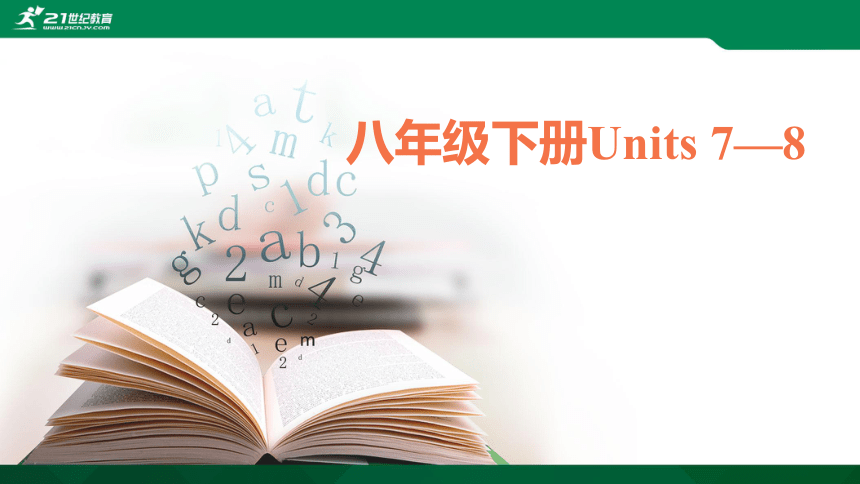 | |
| 格式 | zip | ||
| 文件大小 | 1.4MB | ||
| 资源类型 | 试卷 | ||
| 版本资源 | 人教新目标(Go for it)版 | ||
| 科目 | 英语 | ||
| 更新时间 | 2020-02-21 15:09:27 | ||
图片预览


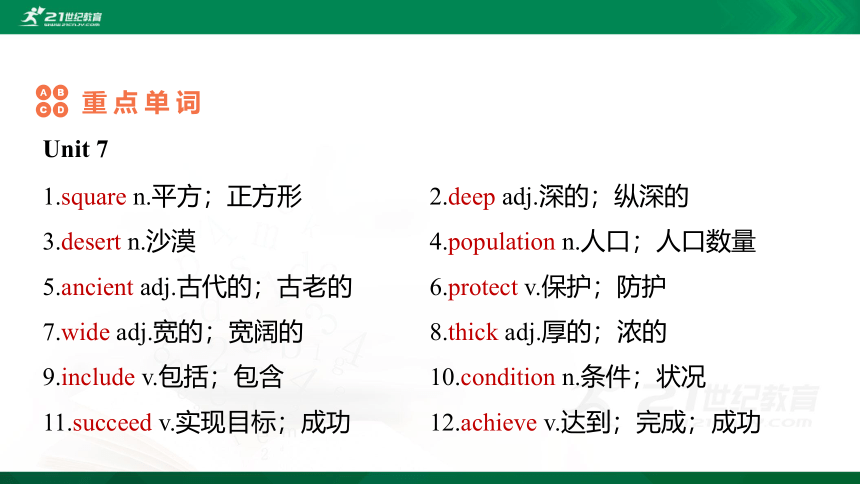
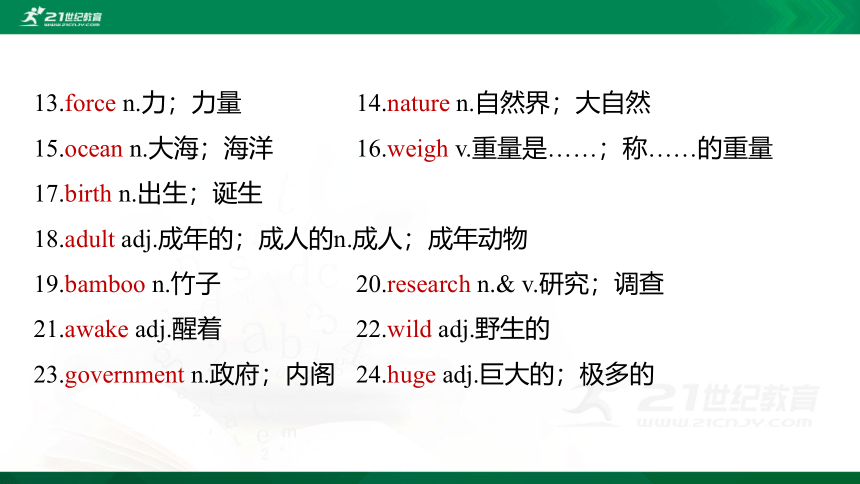
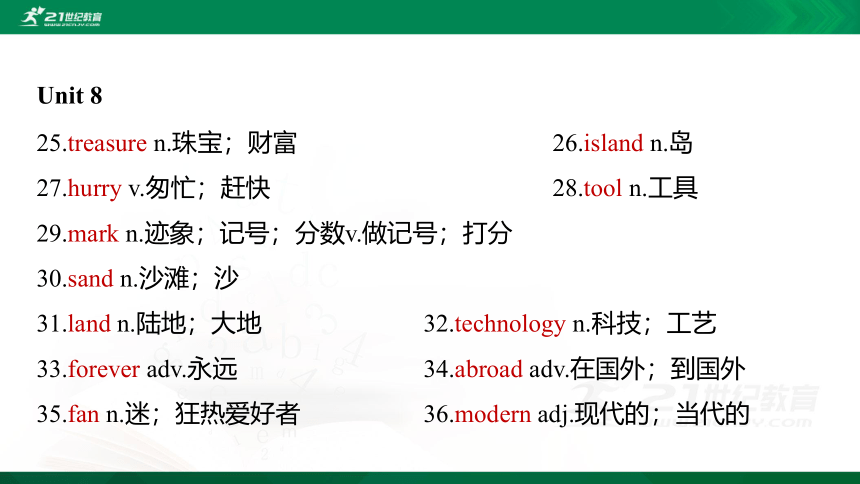
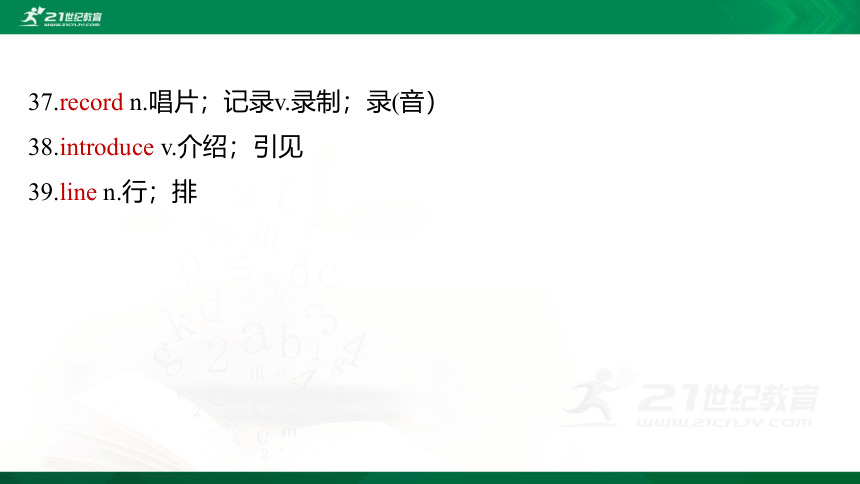
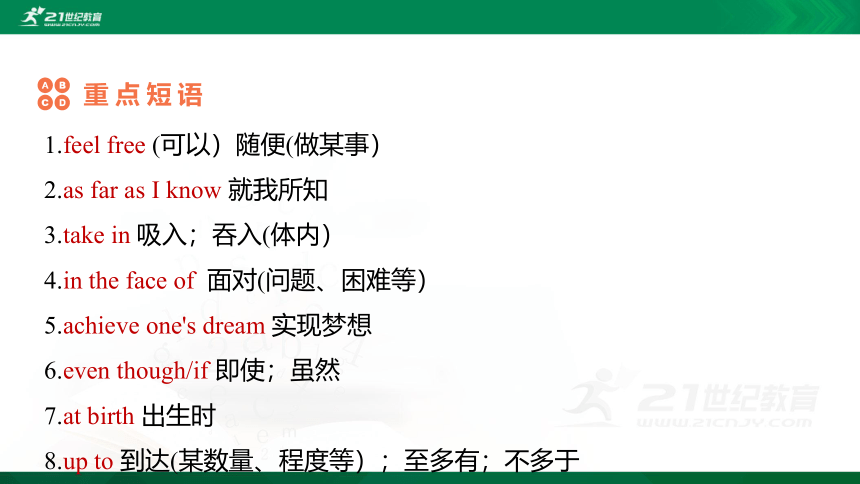
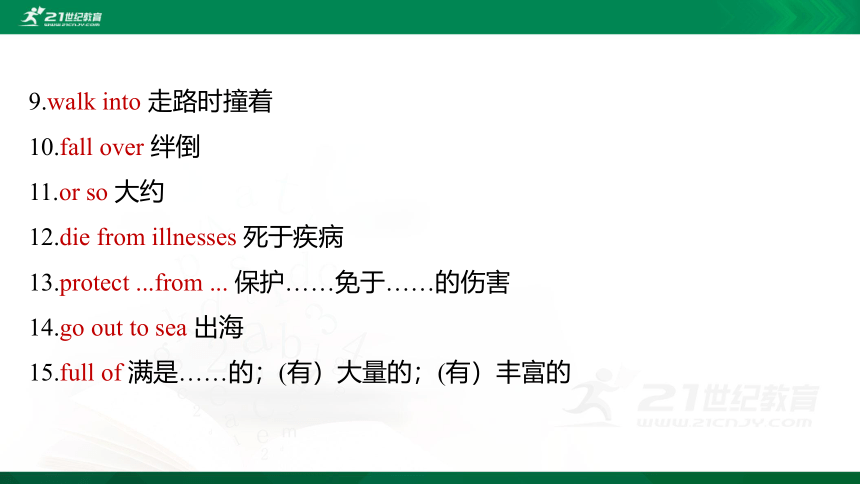
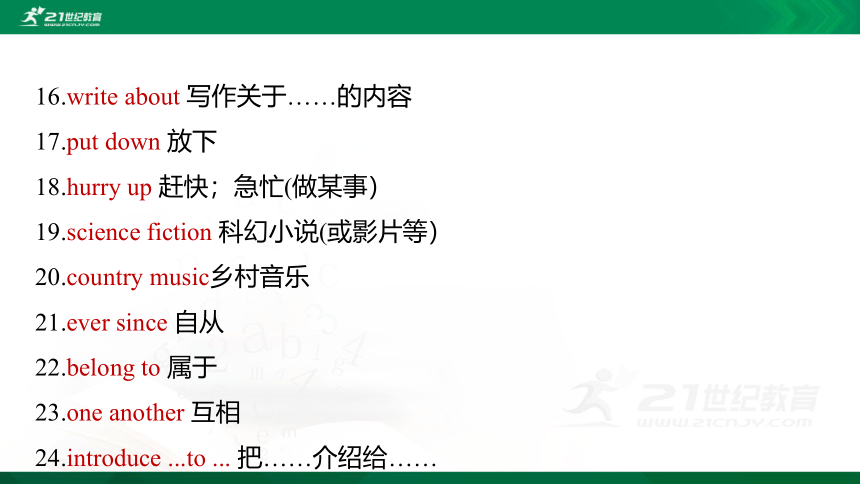
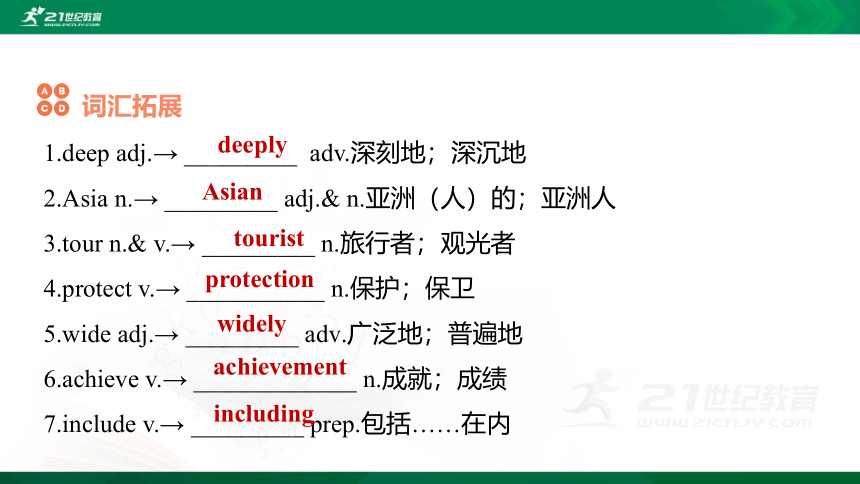
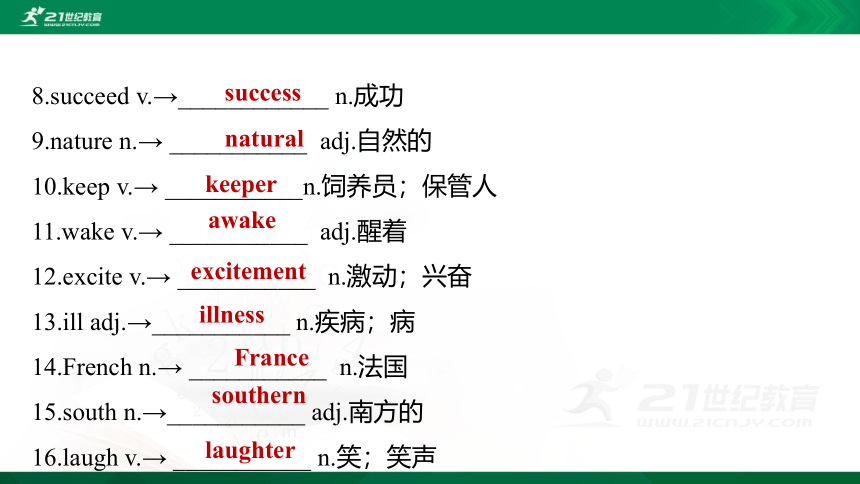
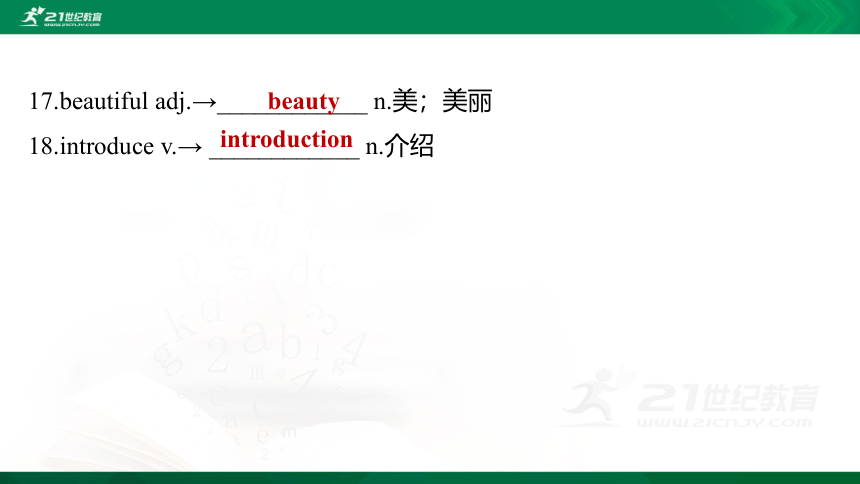
文档简介
(共67张PPT)
八年级下册Units 7—8
核心知识盘点
重 点 单 词
Unit 7
1.square n.平方;正方形 2.deep adj.深的;纵深的
3.desert n.沙漠 4.population n.人口;人口数量
5.ancient adj.古代的;古老的 6.protect v.保护;防护
7.wide adj.宽的;宽阔的 8.thick adj.厚的;浓的
9.include v.包括;包含 10.condition n.条件;状况
11.succeed v.实现目标;成功 12.achieve v.达到;完成;成功
13.force n.力;力量 14.nature n.自然界;大自然
15.ocean n.大海;海洋 16.weigh v.重量是……;称……的重量
17.birth n.出生;诞生
18.adult adj.成年的;成人的n.成人;成年动物
19.bamboo n.竹子 20.research n.& v.研究;调查
21.awake adj.醒着 22.wild adj.野生的
23.government n.政府;内阁 24.huge adj.巨大的;极多的
Unit 8
25.treasure n.珠宝;财富 26.island n.岛
27.hurry v.匆忙;赶快 28.tool n.工具
29.mark n.迹象;记号;分数v.做记号;打分
30.sand n.沙滩;沙
31.land n.陆地;大地 32.technology n.科技;工艺
33.forever adv.永远 34.abroad adv.在国外;到国外
35.fan n.迷;狂热爱好者 36.modern adj.现代的;当代的
37.record n.唱片;记录v.录制;录(音)
38.introduce v.介绍;引见
39.line n.行;排
1.feel free (可以)随便(做某事)
2.as far as I know 就我所知
3.take in 吸入;吞入(体内)
4.in the face of 面对(问题、困难等)
5.achieve one's dream 实现梦想
6.even though/if 即使;虽然
7.at birth 出生时
8.up to 到达(某数量、程度等);至多有;不多于
重 点 短 语
9.walk into 走路时撞着
10.fall over 绊倒
11.or so 大约
12.die from illnesses 死于疾病
13.protect ...from ... 保护……免于……的伤害
14.go out to sea 出海
15.full of 满是……的;(有)大量的;(有)丰富的
16.write about 写作关于……的内容
17.put down 放下
18.hurry up 赶快;急忙(做某事)
19.science fiction 科幻小说(或影片等)
20.country music乡村音乐
21.ever since 自从
22.belong to 属于
23.one another 互相
24.introduce ...to ... 把……介绍给……
1.deep adj.→ _________ adv.深刻地;深沉地
2.Asia n.→ _________ adj.& n.亚洲(人)的;亚洲人
3.tour n.& v.→ _________ n.旅行者;观光者
4.protect v.→ ___________ n.保护;保卫
5.wide adj.→ _________ adv.广泛地;普遍地
6.achieve v.→ _____________ n.成就;成绩
7.include v.→ _________ prep.包括……在内
词汇拓展
deeply
Asian
tourist
protection
widely
achievement
including
8.succeed v.→____________ n.成功
9.nature n.→ ___________ adj.自然的
10.keep v.→ ___________n.饲养员;保管人
11.wake v.→ ___________ adj.醒着
12.excite v.→ ___________ n.激动;兴奋
13.ill adj.→___________ n.疾病;病
14.French n.→ ___________ n.法国
15.south n.→___________ adj.南方的
16.laugh v.→ ___________ n.笑;笑声
success
natural
keeper
awake
excitement
illness
France
southern
laughter
17.beautiful adj.→____________ n.美;美丽
18.introduce v.→ ____________ n.介绍
introduction
beauty
1.It's a lot _____________ _____________ the population of the US.
它(指中国)比美国的人口多得多。
2. _______ _______ _______ I know,there are _______ _______ man-made objects _______ big _______ this.
据我所知,再没有其他像它这样大的人造物体了。
3.The spirit of these climbers shows us that we should never _______ _______ _______ to achieve our dreams.
这些登山者的精神向我们表明:我们决不应该放弃实现自己梦想的尝试。
重 点 句 型
bigger/larger
than
As
far
as
no
other
as
as
give
up
trying
4.She came to ____________ _____ ________ she actually missed all of them.
她开始意识到,事实上她是多么想念他们所有人。
5. ______ ________ then,she _______ _______ a fan of American country music.
自那时起,她就成了美国乡村音乐的乐迷。
6.I hope to see him ______________ one day!
我希望有一天看到他现场演唱!
realize
how
Ever
since
has
been
sing
live
much
谈论自然地理
1.—What's the highest mountain in the world? 世界上最高的山是什么山?
—Qomolangma. 珠穆朗玛峰。
2.—How high is Qomolangma? 珠穆朗玛峰有多高?
—It's 8,844.43 meters high.It's higher than any other mountain.
它有8844.43米高。它比其他任何山峰都高。
情 景 交 际
3.—Which is the deepest salt lake in the world?
世界上最深的咸水湖是哪个?
—The Caspian Sea is the deepest of all the salt lakes.
里海是所有咸水湖中最深的。
谈论最近的事情和经历
4.—Have you read Little Women yet?
你已经读过《小妇人》了吗?
—Yes,I have./No,I haven't.
是的,读过了。/不,还没读。
语 法
话 题
1.基数词(大数字的读法和数量的表达)
2.形容词、副词的比较级和最高级
3.含有already和yet的现在完成时
Unit 7 有关世界的事实
Unit 8 文学和音乐
教材考点解析
Qomolangma is 8,844.43 meters high.
珠穆朗玛峰有8844.43米高。(Unit 7 P49)
【点拨】英语中长、宽、高、深等的表达方式主要有以下两种:
考点一
表达方式 例句
①基数词+量词+形容词(作表语) The river is about 100 meters long.
这条河大约100米长。
②基数词+量词+形容词(作定语) This is a 10-meter-wide river.
这是一条10米宽的河。
表达方式 例句
注:
(1)此处的形容词指的是表示“长、宽、高、深”等的long,wide,high/tall,deep等。
(2)当数词≥2时,①中的量词要用复数。
(3)②为用连字符相连构成的复合形容词,量词用单数。
1.There's a __________________(12米长的) bridge over the river in my hometown.
2.The Great Wall is about_______________(5米宽).
Twelve-meter-long
学以致用
five meters wide
China has the biggest population in the world.
中国是世界上人口最多的国家。(Unit 7 P50)
考点二
【点拨】population是名词,意为“(某一地区的)人口,全体居民”,其用法如下:(1)population是集合名词,常被看作一个整体,一般不加s,常与定冠词the连用,当表示整体人口并作主语时,谓语动词常用第三人称单数形式。如:
The world's population is increasing/growing faster and faster.
全世界的人口增长得越来越快。
注意:有时population可用作可数名词,其前可用不定冠词a。如:
New York is a big city with a population of over 10 million.
纽约是一个有一千多万人口的大城市。
(2)当population被百分数或分数修饰,表示“人口的百分之几或几分之几”并作主语时,谓语动词用单数或复数形式均可。如:
One third of the world's population consumes/consume two thirds of the world's resources.世界上三分之一的人口消耗着全球三分之二的资源。
(3)提问人口数量,一般用:What is the population of ...?如:
What is the population of Canada? 加拿大有多少人口?
(4)表示人口“多”用large/big,表示人口“少”用small,不用many/much/little/few。如:India has a large population.印度人口众多。Singapore has a small population.新加坡人口少。
(5)表示“某地(城市、地区或国家)有多少人口”时,常用以下两种句型:
The population of+某地+be+数词.
某地+has a population of+数词.
The population of the city is about 5 million.
=The city has a population of about 5 million.
这座城市大约有五百万人口。
( )1.— ________the population of your city?
—About 1 million.
A.How is B.What are C.What is
( )2.—We may move to another planet in the future with the population increasing.
—I think so.We will have no other choices if it gets a lot ________.
A.Large B.more C.bigger
C
C
学以致用
Did you know that China is one of the oldest countries in the world?
你知道中国是世界上最古老的国家之一吗?(Unit 7 P50)
【点拨】“one of+the+形容词最高级+可数名词复数”结构,表示“……中最……之一”。当其作主语时,其后的谓语动词要用第三人称单数形式。如:
One of the best ways to learn English is to watch English movies.
学英语的最好方法之一是看英语电影。
考点三
学以致用
1.(2019·广元)Huawei is one of the ________(big) smartphone makers in the world.
2.(2019·常州)Do you believe it is one of the ________(wind) places on the earth?
biggest
windiest
Even more serious difficulties include freezing weather conditions and heavy storms.
更加严峻的困难包括极冷的天气状况和巨大的风暴。(Unit 7 P51)
【辨析】include与including
考点四
单词 词性 含义 用法
include 动词 包括;把……列为一部分 作谓语,侧重指被包含者是整体的一部分。
including 介词 包括……在内 including+名词/代词(位于句中,前用逗号隔开),用于举例,含有补充说明之意。
The tour included a visit to the science museum.
这次游览包括参观科学博物馆。
Thirty passengers were hurt,including five children.
三十名乘客受伤,包括五个孩子。
学以致用
用include的适当形式填空。
1.It's a famous theme park and ________four different parks.
2.The band played many songs,________some of my favorites.
includes
including
...the first woman to succeed was Junko Tabei from Japan in 1975.……
第一个成功(登顶)的女士是1975年来自日本的田部井淳子。(Unit 7 P51)
【辨析】success,succeed与successful
考点五
单词 词性 词义 用法 例句
success 名词 成功 表示抽象意义的“成功”,是不可数名词;表示具体意义的“成功的人或事”,是可数名词。 Failure is the mother of success.
失败是成功之母。
The party was a big success.
这次聚会非常成功。
单词 词性 词义 用法 例句
succeed 动词 成功;
实现
目标 succeed in doing sth.
成功做某事 Jim succeeded in getting the job.
吉姆成功获得了那份工作。
successful 形容词 成功的 可作表语或定语,
be successful in doing sth.成功做某事 The play was very successful on Broadway.
那部剧在百老汇大获成功。
学以致用
用succeed的适当形式填空。
1.We're __________in finding a new house.
2.They didn't have much ________in life.
3.I tried to discuss it with her but only ___________in making her angry.
4.Mr.Black is a __________businessman.
successful
success
succeeded
successful
The spirit of these climbers shows us that we should never give up trying to achieve our dreams.
这些登山者的精神向我们表明:我们决不应该放弃实现自己梦想的尝试。(Unit 7 P51)
【辨析】achieve与come true
考点六
单词/短语 用法
achieve 及物动词,意为“(通过努力)实现;取得;获取;达到(梦想、成绩、成功、目的等)”,主语一般为人。 可用于被动语态
come true 不及物动词短语,意为“实现;成真”,主语一般为希望、梦想等。 不可用于被动语态
+achieve+ = +come true 如:
I have achieved my dream.=My dream has come true.我已经实现了我的梦想。
学以致用
( )1.No one will _______ anything without effort.
A.Succeed B.come true C.achieve
( )2.As long as all the Chinese people pull together,our China Dream will ______.
A.come true B.come out C.come up
C
A
Have you read Little Women yet? 你看过《小妇人》吗?
Yes,I've already read it. 是的,我已经看过它了。(Unit 8 P57)
【辨析】already与yet
考点七
单词 含义 用法 例句
already 已经 常用于现在完成时态的肯定句中(一般置于have/has之后,也可置于句末)。 I have already seen the film.
我已经看过这部电影了。
yet 还;已经 常用于现在完成时态的否定句和疑问句中(一般置于句末)。 I haven't seen the film yet.
我还没看过这部电影。
Have you seen the film yet?
你已经看过这部电影了吗?
注:already与yet通常与现在完成时连用。
学以致用
( )1.I have _______ finished my homework.I finished it an hour ago.
A.Yet B.already C.ever
( )2.—Have you had the English test _______?
—No,not ______.But we've had the math test _______.
A.already;yet;yet B.yet;already;yet C.yet;yet;already
B
C
语法精讲精练
语法一致是指句子的主语和谓语通常在语法形式上保持一致。即主语是单数形式时,谓语动词用单数形式;主语是复数形式时,谓语动词用复数形式。
考点一 语法一致原则
主谓一致
使用情况 例句
当单数可数名词、单数代词、不可数名词作主语时,谓语动词用单数形式;当复数可数名词、复数代词作主语时,谓语动词用复数形式。 A girl is singing on the stage.
一个女孩正在舞台上唱歌。
They have been there twice.
他们去过那儿两次了。
当单个不定式(短语)/动名词(短语)作主语时,谓语动词用单数形式。 Reading is a good way of learning.
阅读是一种好的学习方式。
使用情况 例句
当and或both ...and ...连接并列主语表示两个或两个以上的人或物时,谓语动词用复数形式。 Both her father and her mother are teachers.
她的爸爸和妈妈都是老师。
当不定代词either,neither,one,much,everything,somebody,anything等作主语时,谓语动词用单数形式。 Everyone is ready for the sports meeting.
每个人都为运动会做好了准备。
当each,each ...(and each ...),every ...(and every ...)作主语时,谓语动词用单数形式。 Every boy and every girl has the right to receive education.
每个男孩和女孩都有接受教育的权利。
使用情况 例句
当“one of+名词/代词复数”(表示“……之一”)作主语时,谓语动词用单数形式。 One of these books is written by my uncle.
这些书中有一本是我叔叔写的。
当主语后接有with,along/together with,as well as,including,besides,like,except,but等词或短语时,谓语动词的形式由主语的单复数形式决定。 Diana,together with her friends,is flying kites in the park.
戴安娜和她的朋友们正在公园里放风筝。
当“a number of+名词复数”作主语时,谓语动词用复数形式;当“the number of+名词复数”作主语时,谓语动词用单数形式。 A number of girls are playing tennis there.
很多女孩在那儿打网球。
The number of the men teachers in our school is more than 50.
我们学校男教师的人数超过了50。
使用情况 例句
当“a lot of/lots of/plenty of/most of/the rest of+名词”或“分数/百分数+名词”等作主语时,谓语动词的单复数取决于名词。若名词是单数可数名词或不可数名词,则谓语动词用单数形式;若名词是复数可数名词,则谓语动词用复数形式。 Lots of boys in our school are fond of playing football.
我们学校很多男孩喜欢踢足球。
Two thirds of the work has been finished.三分之二的工作已经做完了。
注意:由and连接的并列主语如果是指同一概念(即and后面无冠词),则谓语动词用单数形式。如:
The writer and professor is very popular in our school.
这位作家兼教授在我们学校很受欢迎。
学以致用
1.The book ________(describe) how tea plants ________(was) grown and used to make tea.
2.One of the world's most dangerous sports ________(be) mountain climbing.
3.Jim together with his parents ________(be) going to travel next week.
4.Both Tom and Peter ________(like) playing ping-pong.
5.If a shark doesn't have a fin,it can no longer swim and slowly ________(die).
describes
were
is
is
like
dies
意义一致又叫概念一致,即谓语动词用单数形式还是复数形式要看主语表达的概念。
考点二 意义一致原则
使用情况 例句
表示时间、距离、金钱、价格、重量、长度等的复合名词作主语时,通常被看作是一个整体,谓语动词用单数形式。 Ten years is a long time.
十年是一段很长的时间。集体名词(family,team,crowd,class,group等)
如果表示集体概念,谓语动词用单数形式;如果表示集体中的成员,谓语动词则用复数形式。 My family all like watching sports on TV.
我的家人都喜欢在电视上观看体育节目。
使用情况 例句
politics,physics,works,the United States,news,maths 等词作主语时,虽以?s结尾,但表示单数意义,谓语动词用单数形式。 Maths is difficult to learn.
数学很难学。
形式上虽为单数,但意义为复数的名词,如people,police,cattle等作主语时,谓语动词用复数形式。 The police are looking for the two missing children.
警察正在寻找那两个失踪的孩子。
“the+形容词”作主语时,表示某一类人,谓语动词常用复数形式。 The old in our town are taken good care of.
我们镇上的老人被照顾得很好。
使用情况 例句
trousers,glasses,clothes,shoes,shorts等词作主语时,谓语动词用复数形式;如果前面有a pair of,two pairs of 等量词修饰时,谓语动词的单复数形式要与pair保持一致。 That pair of jeans is too expensive.
那条牛仔裤太贵了。
“the+姓氏名词复数”表示“……一家”或“……夫妇”,作主语时谓语动词用复数形式。 The Smiths are in Beijing now.
史密斯一家现在在北京。
学以致用
用is,are填空。
1.Twenty dollars ________ enough to buy that T-shirt.
2.Look! The police ________ carrying the food onto the bank of the river.
3.Maths ________ the language of science.
4.This pair of glasses ________ mine.
is
are
is
is
有时谓语动词的形式与主语并不一致,而是与最靠近它的名词或代词一致,这种原则叫“就近一致”原则。
考点三 就近一致原则
使用情况 例句
使用情况例句在There be句型中,be动词须与邻近的主语在数上保持一致。 There is a book and two notebooks on the desk.
桌子上有一本书和两本笔记本。
There are two notebooks and a book on the desk.
桌子上有两本笔记本和一本书。
由either ...or ...,neither ...nor ...,not only ...but (also) ...,not ...but ...或or连接两个并列主语时,谓语动词与邻近的主语在人称和数上保持一致。 Not only the students but also the teacher enjoys listening to the song.
不仅是学生,就连老师也喜欢听这首歌。
Neither you nor he is wrong.
你没错,他也没错。
学以致用
用am,is,are填空。
1.Either you or I ________ going to the teachers' office after class.
2.There ________ a table and some chairs in the dining room.
3.Not only Alan but also his parents ______interested in the TV show.
am
is
are
语法专练
( )1.(2019·新疆)Not only Jack but also _______ I crazy about the football match.
A.am B.is C.are
( )2.(2019·天水)Either the students or the teacher ________ him very well.
A.knows B.to know C.know
( )3.(2019·广元)Not only you but also I interested in the cartoon called Peppa Pig.
A.am B.is C.are
A
A
A
( )4.(2019·百色)Neither my sister nor I ______ been to Xi'an before.
A.have never B.have ever C.has never
( )5.(2019·湘西改编)—There _______ a book sale in our school.Would you like to have a look with me?
—Sure.I'd love to.
A.is B.have C.are
( )6.(2019·郴州改编)—Lucy,there _______ too many things on the desk.What a mess!
—Sorry,Mum.I'll put them away.
A.have B.is C.are
A
C
B
( )7.(2019·凉山)—What's in the picture on the wall?
—There ______ a teacher and some students playing soccer on the playground.
A.has B.are C.is
( )8.(2019·绥化改编)Eighty percent of the students in this school ______ three to five times a week.
A.exercises B.exercise C.exercising
( )9.(2019·临沂改编)—I'm getting hungry.Do you know where we can get some good food?
—Of course!There_______ a restaurant around the corner.
A.will be B.was C.is
C
B
C
谢谢
21世纪教育网(www.21cnjy.com) 中小学教育资源网站
有大把高质量资料?一线教师?一线教研员?
欢迎加入21世纪教育网教师合作团队!!月薪过万不是梦!!
详情请看:
https://www.21cnjy.com/help/help_extract.php
八年级下册Units 7—8
核心知识盘点
重 点 单 词
Unit 7
1.square n.平方;正方形 2.deep adj.深的;纵深的
3.desert n.沙漠 4.population n.人口;人口数量
5.ancient adj.古代的;古老的 6.protect v.保护;防护
7.wide adj.宽的;宽阔的 8.thick adj.厚的;浓的
9.include v.包括;包含 10.condition n.条件;状况
11.succeed v.实现目标;成功 12.achieve v.达到;完成;成功
13.force n.力;力量 14.nature n.自然界;大自然
15.ocean n.大海;海洋 16.weigh v.重量是……;称……的重量
17.birth n.出生;诞生
18.adult adj.成年的;成人的n.成人;成年动物
19.bamboo n.竹子 20.research n.& v.研究;调查
21.awake adj.醒着 22.wild adj.野生的
23.government n.政府;内阁 24.huge adj.巨大的;极多的
Unit 8
25.treasure n.珠宝;财富 26.island n.岛
27.hurry v.匆忙;赶快 28.tool n.工具
29.mark n.迹象;记号;分数v.做记号;打分
30.sand n.沙滩;沙
31.land n.陆地;大地 32.technology n.科技;工艺
33.forever adv.永远 34.abroad adv.在国外;到国外
35.fan n.迷;狂热爱好者 36.modern adj.现代的;当代的
37.record n.唱片;记录v.录制;录(音)
38.introduce v.介绍;引见
39.line n.行;排
1.feel free (可以)随便(做某事)
2.as far as I know 就我所知
3.take in 吸入;吞入(体内)
4.in the face of 面对(问题、困难等)
5.achieve one's dream 实现梦想
6.even though/if 即使;虽然
7.at birth 出生时
8.up to 到达(某数量、程度等);至多有;不多于
重 点 短 语
9.walk into 走路时撞着
10.fall over 绊倒
11.or so 大约
12.die from illnesses 死于疾病
13.protect ...from ... 保护……免于……的伤害
14.go out to sea 出海
15.full of 满是……的;(有)大量的;(有)丰富的
16.write about 写作关于……的内容
17.put down 放下
18.hurry up 赶快;急忙(做某事)
19.science fiction 科幻小说(或影片等)
20.country music乡村音乐
21.ever since 自从
22.belong to 属于
23.one another 互相
24.introduce ...to ... 把……介绍给……
1.deep adj.→ _________ adv.深刻地;深沉地
2.Asia n.→ _________ adj.& n.亚洲(人)的;亚洲人
3.tour n.& v.→ _________ n.旅行者;观光者
4.protect v.→ ___________ n.保护;保卫
5.wide adj.→ _________ adv.广泛地;普遍地
6.achieve v.→ _____________ n.成就;成绩
7.include v.→ _________ prep.包括……在内
词汇拓展
deeply
Asian
tourist
protection
widely
achievement
including
8.succeed v.→____________ n.成功
9.nature n.→ ___________ adj.自然的
10.keep v.→ ___________n.饲养员;保管人
11.wake v.→ ___________ adj.醒着
12.excite v.→ ___________ n.激动;兴奋
13.ill adj.→___________ n.疾病;病
14.French n.→ ___________ n.法国
15.south n.→___________ adj.南方的
16.laugh v.→ ___________ n.笑;笑声
success
natural
keeper
awake
excitement
illness
France
southern
laughter
17.beautiful adj.→____________ n.美;美丽
18.introduce v.→ ____________ n.介绍
introduction
beauty
1.It's a lot _____________ _____________ the population of the US.
它(指中国)比美国的人口多得多。
2. _______ _______ _______ I know,there are _______ _______ man-made objects _______ big _______ this.
据我所知,再没有其他像它这样大的人造物体了。
3.The spirit of these climbers shows us that we should never _______ _______ _______ to achieve our dreams.
这些登山者的精神向我们表明:我们决不应该放弃实现自己梦想的尝试。
重 点 句 型
bigger/larger
than
As
far
as
no
other
as
as
give
up
trying
4.She came to ____________ _____ ________ she actually missed all of them.
她开始意识到,事实上她是多么想念他们所有人。
5. ______ ________ then,she _______ _______ a fan of American country music.
自那时起,她就成了美国乡村音乐的乐迷。
6.I hope to see him ______________ one day!
我希望有一天看到他现场演唱!
realize
how
Ever
since
has
been
sing
live
much
谈论自然地理
1.—What's the highest mountain in the world? 世界上最高的山是什么山?
—Qomolangma. 珠穆朗玛峰。
2.—How high is Qomolangma? 珠穆朗玛峰有多高?
—It's 8,844.43 meters high.It's higher than any other mountain.
它有8844.43米高。它比其他任何山峰都高。
情 景 交 际
3.—Which is the deepest salt lake in the world?
世界上最深的咸水湖是哪个?
—The Caspian Sea is the deepest of all the salt lakes.
里海是所有咸水湖中最深的。
谈论最近的事情和经历
4.—Have you read Little Women yet?
你已经读过《小妇人》了吗?
—Yes,I have./No,I haven't.
是的,读过了。/不,还没读。
语 法
话 题
1.基数词(大数字的读法和数量的表达)
2.形容词、副词的比较级和最高级
3.含有already和yet的现在完成时
Unit 7 有关世界的事实
Unit 8 文学和音乐
教材考点解析
Qomolangma is 8,844.43 meters high.
珠穆朗玛峰有8844.43米高。(Unit 7 P49)
【点拨】英语中长、宽、高、深等的表达方式主要有以下两种:
考点一
表达方式 例句
①基数词+量词+形容词(作表语) The river is about 100 meters long.
这条河大约100米长。
②基数词+量词+形容词(作定语) This is a 10-meter-wide river.
这是一条10米宽的河。
表达方式 例句
注:
(1)此处的形容词指的是表示“长、宽、高、深”等的long,wide,high/tall,deep等。
(2)当数词≥2时,①中的量词要用复数。
(3)②为用连字符相连构成的复合形容词,量词用单数。
1.There's a __________________(12米长的) bridge over the river in my hometown.
2.The Great Wall is about_______________(5米宽).
Twelve-meter-long
学以致用
five meters wide
China has the biggest population in the world.
中国是世界上人口最多的国家。(Unit 7 P50)
考点二
【点拨】population是名词,意为“(某一地区的)人口,全体居民”,其用法如下:(1)population是集合名词,常被看作一个整体,一般不加s,常与定冠词the连用,当表示整体人口并作主语时,谓语动词常用第三人称单数形式。如:
The world's population is increasing/growing faster and faster.
全世界的人口增长得越来越快。
注意:有时population可用作可数名词,其前可用不定冠词a。如:
New York is a big city with a population of over 10 million.
纽约是一个有一千多万人口的大城市。
(2)当population被百分数或分数修饰,表示“人口的百分之几或几分之几”并作主语时,谓语动词用单数或复数形式均可。如:
One third of the world's population consumes/consume two thirds of the world's resources.世界上三分之一的人口消耗着全球三分之二的资源。
(3)提问人口数量,一般用:What is the population of ...?如:
What is the population of Canada? 加拿大有多少人口?
(4)表示人口“多”用large/big,表示人口“少”用small,不用many/much/little/few。如:India has a large population.印度人口众多。Singapore has a small population.新加坡人口少。
(5)表示“某地(城市、地区或国家)有多少人口”时,常用以下两种句型:
The population of+某地+be+数词.
某地+has a population of+数词.
The population of the city is about 5 million.
=The city has a population of about 5 million.
这座城市大约有五百万人口。
( )1.— ________the population of your city?
—About 1 million.
A.How is B.What are C.What is
( )2.—We may move to another planet in the future with the population increasing.
—I think so.We will have no other choices if it gets a lot ________.
A.Large B.more C.bigger
C
C
学以致用
Did you know that China is one of the oldest countries in the world?
你知道中国是世界上最古老的国家之一吗?(Unit 7 P50)
【点拨】“one of+the+形容词最高级+可数名词复数”结构,表示“……中最……之一”。当其作主语时,其后的谓语动词要用第三人称单数形式。如:
One of the best ways to learn English is to watch English movies.
学英语的最好方法之一是看英语电影。
考点三
学以致用
1.(2019·广元)Huawei is one of the ________(big) smartphone makers in the world.
2.(2019·常州)Do you believe it is one of the ________(wind) places on the earth?
biggest
windiest
Even more serious difficulties include freezing weather conditions and heavy storms.
更加严峻的困难包括极冷的天气状况和巨大的风暴。(Unit 7 P51)
【辨析】include与including
考点四
单词 词性 含义 用法
include 动词 包括;把……列为一部分 作谓语,侧重指被包含者是整体的一部分。
including 介词 包括……在内 including+名词/代词(位于句中,前用逗号隔开),用于举例,含有补充说明之意。
The tour included a visit to the science museum.
这次游览包括参观科学博物馆。
Thirty passengers were hurt,including five children.
三十名乘客受伤,包括五个孩子。
学以致用
用include的适当形式填空。
1.It's a famous theme park and ________four different parks.
2.The band played many songs,________some of my favorites.
includes
including
...the first woman to succeed was Junko Tabei from Japan in 1975.……
第一个成功(登顶)的女士是1975年来自日本的田部井淳子。(Unit 7 P51)
【辨析】success,succeed与successful
考点五
单词 词性 词义 用法 例句
success 名词 成功 表示抽象意义的“成功”,是不可数名词;表示具体意义的“成功的人或事”,是可数名词。 Failure is the mother of success.
失败是成功之母。
The party was a big success.
这次聚会非常成功。
单词 词性 词义 用法 例句
succeed 动词 成功;
实现
目标 succeed in doing sth.
成功做某事 Jim succeeded in getting the job.
吉姆成功获得了那份工作。
successful 形容词 成功的 可作表语或定语,
be successful in doing sth.成功做某事 The play was very successful on Broadway.
那部剧在百老汇大获成功。
学以致用
用succeed的适当形式填空。
1.We're __________in finding a new house.
2.They didn't have much ________in life.
3.I tried to discuss it with her but only ___________in making her angry.
4.Mr.Black is a __________businessman.
successful
success
succeeded
successful
The spirit of these climbers shows us that we should never give up trying to achieve our dreams.
这些登山者的精神向我们表明:我们决不应该放弃实现自己梦想的尝试。(Unit 7 P51)
【辨析】achieve与come true
考点六
单词/短语 用法
achieve 及物动词,意为“(通过努力)实现;取得;获取;达到(梦想、成绩、成功、目的等)”,主语一般为人。 可用于被动语态
come true 不及物动词短语,意为“实现;成真”,主语一般为希望、梦想等。 不可用于被动语态
+achieve+ = +come true 如:
I have achieved my dream.=My dream has come true.我已经实现了我的梦想。
学以致用
( )1.No one will _______ anything without effort.
A.Succeed B.come true C.achieve
( )2.As long as all the Chinese people pull together,our China Dream will ______.
A.come true B.come out C.come up
C
A
Have you read Little Women yet? 你看过《小妇人》吗?
Yes,I've already read it. 是的,我已经看过它了。(Unit 8 P57)
【辨析】already与yet
考点七
单词 含义 用法 例句
already 已经 常用于现在完成时态的肯定句中(一般置于have/has之后,也可置于句末)。 I have already seen the film.
我已经看过这部电影了。
yet 还;已经 常用于现在完成时态的否定句和疑问句中(一般置于句末)。 I haven't seen the film yet.
我还没看过这部电影。
Have you seen the film yet?
你已经看过这部电影了吗?
注:already与yet通常与现在完成时连用。
学以致用
( )1.I have _______ finished my homework.I finished it an hour ago.
A.Yet B.already C.ever
( )2.—Have you had the English test _______?
—No,not ______.But we've had the math test _______.
A.already;yet;yet B.yet;already;yet C.yet;yet;already
B
C
语法精讲精练
语法一致是指句子的主语和谓语通常在语法形式上保持一致。即主语是单数形式时,谓语动词用单数形式;主语是复数形式时,谓语动词用复数形式。
考点一 语法一致原则
主谓一致
使用情况 例句
当单数可数名词、单数代词、不可数名词作主语时,谓语动词用单数形式;当复数可数名词、复数代词作主语时,谓语动词用复数形式。 A girl is singing on the stage.
一个女孩正在舞台上唱歌。
They have been there twice.
他们去过那儿两次了。
当单个不定式(短语)/动名词(短语)作主语时,谓语动词用单数形式。 Reading is a good way of learning.
阅读是一种好的学习方式。
使用情况 例句
当and或both ...and ...连接并列主语表示两个或两个以上的人或物时,谓语动词用复数形式。 Both her father and her mother are teachers.
她的爸爸和妈妈都是老师。
当不定代词either,neither,one,much,everything,somebody,anything等作主语时,谓语动词用单数形式。 Everyone is ready for the sports meeting.
每个人都为运动会做好了准备。
当each,each ...(and each ...),every ...(and every ...)作主语时,谓语动词用单数形式。 Every boy and every girl has the right to receive education.
每个男孩和女孩都有接受教育的权利。
使用情况 例句
当“one of+名词/代词复数”(表示“……之一”)作主语时,谓语动词用单数形式。 One of these books is written by my uncle.
这些书中有一本是我叔叔写的。
当主语后接有with,along/together with,as well as,including,besides,like,except,but等词或短语时,谓语动词的形式由主语的单复数形式决定。 Diana,together with her friends,is flying kites in the park.
戴安娜和她的朋友们正在公园里放风筝。
当“a number of+名词复数”作主语时,谓语动词用复数形式;当“the number of+名词复数”作主语时,谓语动词用单数形式。 A number of girls are playing tennis there.
很多女孩在那儿打网球。
The number of the men teachers in our school is more than 50.
我们学校男教师的人数超过了50。
使用情况 例句
当“a lot of/lots of/plenty of/most of/the rest of+名词”或“分数/百分数+名词”等作主语时,谓语动词的单复数取决于名词。若名词是单数可数名词或不可数名词,则谓语动词用单数形式;若名词是复数可数名词,则谓语动词用复数形式。 Lots of boys in our school are fond of playing football.
我们学校很多男孩喜欢踢足球。
Two thirds of the work has been finished.三分之二的工作已经做完了。
注意:由and连接的并列主语如果是指同一概念(即and后面无冠词),则谓语动词用单数形式。如:
The writer and professor is very popular in our school.
这位作家兼教授在我们学校很受欢迎。
学以致用
1.The book ________(describe) how tea plants ________(was) grown and used to make tea.
2.One of the world's most dangerous sports ________(be) mountain climbing.
3.Jim together with his parents ________(be) going to travel next week.
4.Both Tom and Peter ________(like) playing ping-pong.
5.If a shark doesn't have a fin,it can no longer swim and slowly ________(die).
describes
were
is
is
like
dies
意义一致又叫概念一致,即谓语动词用单数形式还是复数形式要看主语表达的概念。
考点二 意义一致原则
使用情况 例句
表示时间、距离、金钱、价格、重量、长度等的复合名词作主语时,通常被看作是一个整体,谓语动词用单数形式。 Ten years is a long time.
十年是一段很长的时间。集体名词(family,team,crowd,class,group等)
如果表示集体概念,谓语动词用单数形式;如果表示集体中的成员,谓语动词则用复数形式。 My family all like watching sports on TV.
我的家人都喜欢在电视上观看体育节目。
使用情况 例句
politics,physics,works,the United States,news,maths 等词作主语时,虽以?s结尾,但表示单数意义,谓语动词用单数形式。 Maths is difficult to learn.
数学很难学。
形式上虽为单数,但意义为复数的名词,如people,police,cattle等作主语时,谓语动词用复数形式。 The police are looking for the two missing children.
警察正在寻找那两个失踪的孩子。
“the+形容词”作主语时,表示某一类人,谓语动词常用复数形式。 The old in our town are taken good care of.
我们镇上的老人被照顾得很好。
使用情况 例句
trousers,glasses,clothes,shoes,shorts等词作主语时,谓语动词用复数形式;如果前面有a pair of,two pairs of 等量词修饰时,谓语动词的单复数形式要与pair保持一致。 That pair of jeans is too expensive.
那条牛仔裤太贵了。
“the+姓氏名词复数”表示“……一家”或“……夫妇”,作主语时谓语动词用复数形式。 The Smiths are in Beijing now.
史密斯一家现在在北京。
学以致用
用is,are填空。
1.Twenty dollars ________ enough to buy that T-shirt.
2.Look! The police ________ carrying the food onto the bank of the river.
3.Maths ________ the language of science.
4.This pair of glasses ________ mine.
is
are
is
is
有时谓语动词的形式与主语并不一致,而是与最靠近它的名词或代词一致,这种原则叫“就近一致”原则。
考点三 就近一致原则
使用情况 例句
使用情况例句在There be句型中,be动词须与邻近的主语在数上保持一致。 There is a book and two notebooks on the desk.
桌子上有一本书和两本笔记本。
There are two notebooks and a book on the desk.
桌子上有两本笔记本和一本书。
由either ...or ...,neither ...nor ...,not only ...but (also) ...,not ...but ...或or连接两个并列主语时,谓语动词与邻近的主语在人称和数上保持一致。 Not only the students but also the teacher enjoys listening to the song.
不仅是学生,就连老师也喜欢听这首歌。
Neither you nor he is wrong.
你没错,他也没错。
学以致用
用am,is,are填空。
1.Either you or I ________ going to the teachers' office after class.
2.There ________ a table and some chairs in the dining room.
3.Not only Alan but also his parents ______interested in the TV show.
am
is
are
语法专练
( )1.(2019·新疆)Not only Jack but also _______ I crazy about the football match.
A.am B.is C.are
( )2.(2019·天水)Either the students or the teacher ________ him very well.
A.knows B.to know C.know
( )3.(2019·广元)Not only you but also I interested in the cartoon called Peppa Pig.
A.am B.is C.are
A
A
A
( )4.(2019·百色)Neither my sister nor I ______ been to Xi'an before.
A.have never B.have ever C.has never
( )5.(2019·湘西改编)—There _______ a book sale in our school.Would you like to have a look with me?
—Sure.I'd love to.
A.is B.have C.are
( )6.(2019·郴州改编)—Lucy,there _______ too many things on the desk.What a mess!
—Sorry,Mum.I'll put them away.
A.have B.is C.are
A
C
B
( )7.(2019·凉山)—What's in the picture on the wall?
—There ______ a teacher and some students playing soccer on the playground.
A.has B.are C.is
( )8.(2019·绥化改编)Eighty percent of the students in this school ______ three to five times a week.
A.exercises B.exercise C.exercising
( )9.(2019·临沂改编)—I'm getting hungry.Do you know where we can get some good food?
—Of course!There_______ a restaurant around the corner.
A.will be B.was C.is
C
B
C
谢谢
21世纪教育网(www.21cnjy.com) 中小学教育资源网站
有大把高质量资料?一线教师?一线教研员?
欢迎加入21世纪教育网教师合作团队!!月薪过万不是梦!!
详情请看:
https://www.21cnjy.com/help/help_extract.php
